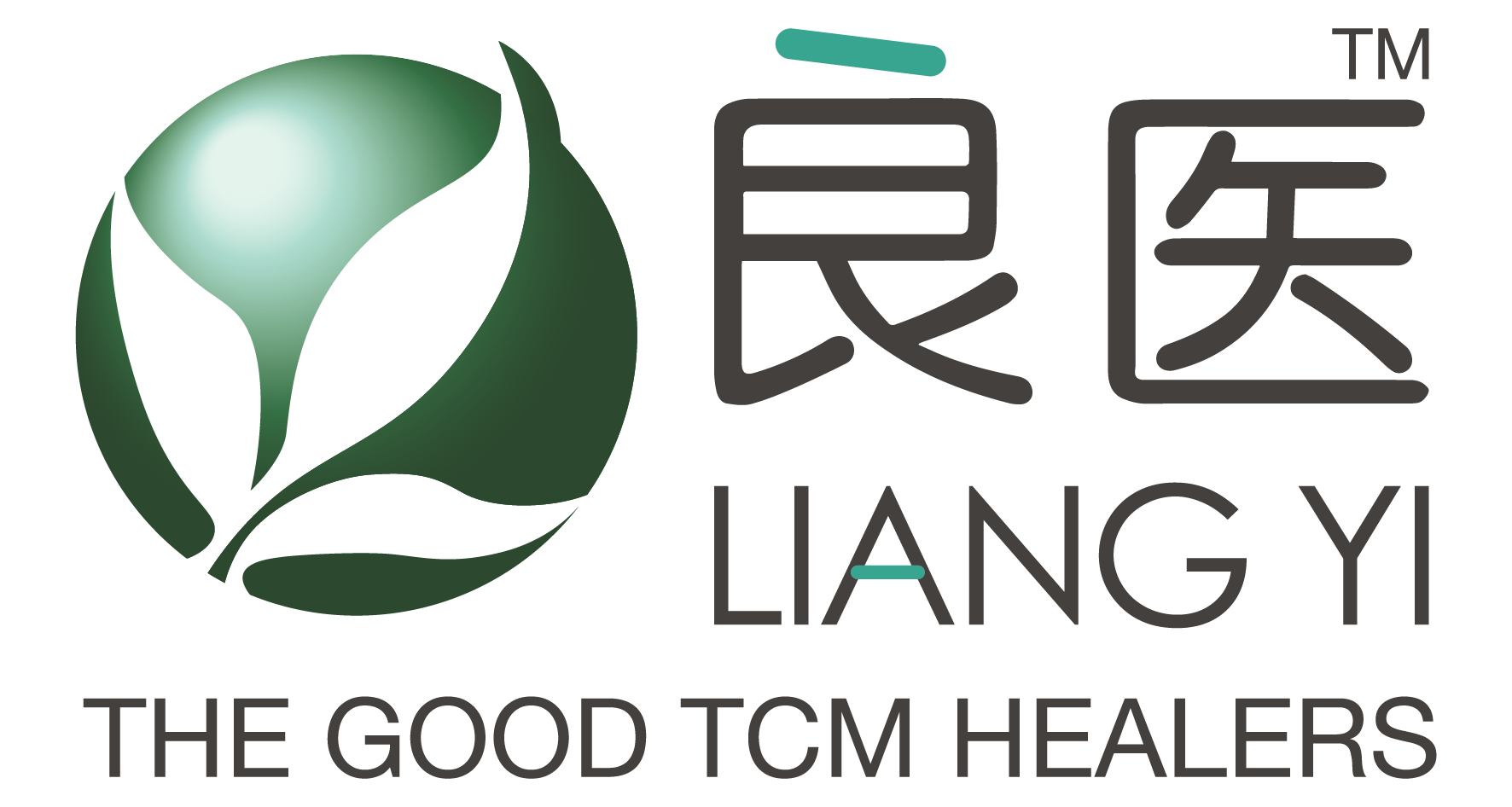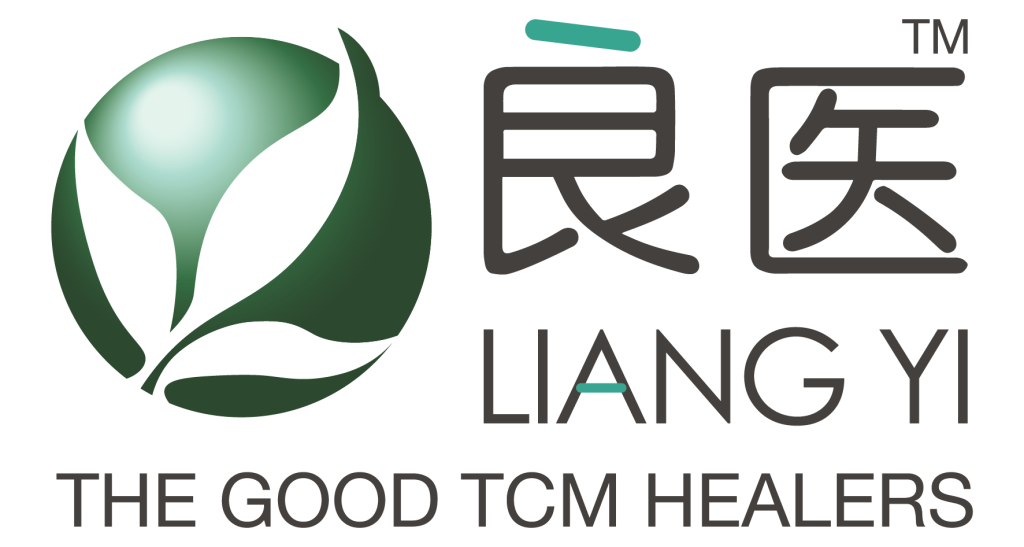Introduction
In today’s screen-centred lifestyle, we spend hours each day looking down at smartphones, laptops, and tablets. Most of us don’t realise how much this affects our posture. This forward-tilted position, commonly known as “tech neck,” puts continuous strain on the muscles and ligaments that support the neck. Over time, this can lead to discomfort, such as stiffness, soreness, and muscle fatigue.
The issue is especially noticeable among office workers, students, and frequent mobile users in Singapore, where long hours of digital use are part of daily life. While remedies like stretching or over-the-counter pain relief can ease symptoms in the short term, they may not address the underlying causes.
In this context, Traditional Chinese Medicine (TCM) acupuncture in Singapore may offer a holistic approach to managing tech neck and supporting the body’s natural balance. Keep reading for further insights.
Key Takeaways:
- What is tech neck and why does it happen?
It refers to discomfort, stiffness, or strain in the neck caused by prolonged use of digital devices and forward head posture, which places continuous stress on the cervical spine. - What everyday habits contribute to tech neck?
Habits such as poor ergonomics, weak supporting muscles, emotional stress, and repetitive posture patterns all contribute to the condition. Even small daily actions can intensify its effects over time. - What happens if tech neck is ignored?
If left unaddressed, tech neck may lead to long-term issues such as chronic pain, spinal misalignment, disc pressure, and early joint wear. This highlights the importance of early prevention and management. - How can TCM approaches help manage tech neck?
Treatments such as acupuncture aim to restore internal balance, ease muscle tension, and support better posture.
What You Need to Know About Tech Neck
What Is Tech Neck?
Tech neck, also known as text neck or screen neck, refers to the discomfort, stiffness, or strain that develops in the neck due to prolonged use of digital devices. It occurs when we repeatedly tilt our heads forward to look down at screens, a posture that places the cervical spine under continuous stress.
The human head typically weighs around 4.5 to 5.5 kilograms. However, when tilted forward even slightly, the strain on the neck intensifies with each degree of tilt. In the long run, this added pressure can fatigue muscles, tighten ligaments, and reduce mobility in the upper spine.

What Causes It?
After understanding what tech neck is, it’s important to look at the habits and factors that contribute to its development. This condition is rarely caused by one single action. In fact, it results from a combination of posture patterns, lifestyle choices, and physical responses that place ongoing stress on the neck and upper spine.
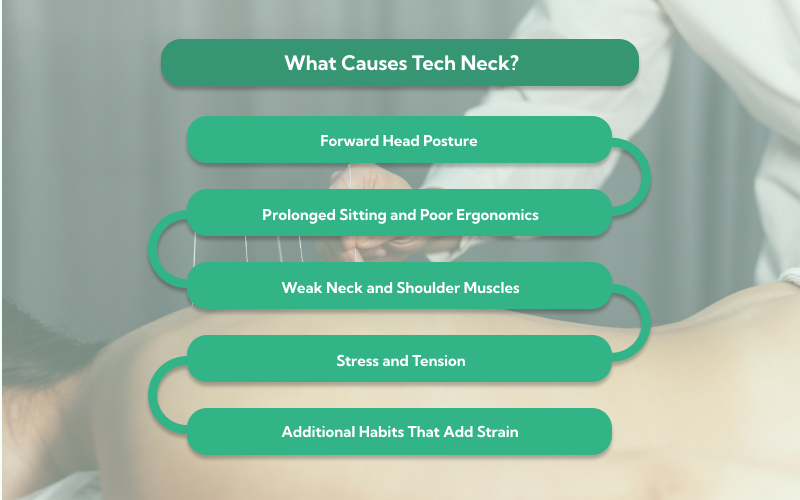
1. Forward Head Posture
Constantly looking down at phones or tablets shifts the head into a flexed position, moving it out of its natural alignment with the spine. Even a slight tilt forward increases the load on the cervical spine, forcing the neck muscles to work harder to support the head. This repeated strain can lead to tightness, soreness, and reduced range of motion.
2. Prolonged Sitting and Poor Ergonomics
Many people spend hours seated at computers without an ergonomically sound setup. Screens positioned too low, desks that are too high, or chairs that lack proper lumbar support can all encourage slouching and forward-leaning postures. These positions increase tension in the neck and shoulders and make tech neck more likely to occur.

3. Weak Neck and Shoulder Muscles
When the muscles that support the neck and upper back are weak, maintaining an upright posture becomes more difficult. Prolonged static positions, such as sitting at a desk for long periods, can place additional strain on these muscles.
4. Stress and Tension
Even though stress is psychological, its effects are often felt physically, particularly as muscle tightness. Chronic stress can cause the shoulders and neck to tense up, increasing stiffness and worsening existing posture. When combined with long hours of device use, this tension may amplify the effects of tech neck.
5. Additional Habits That Add Strain
Everyday actions may intensify neck strain, manifesting as muscular fatigue and spinal stress. For instance, cradling a phone between the shoulder and ear, carrying heavy bags that pull the shoulders forward, and maintaining the same position for hours without movement. After some time, these seemingly minor habits are likely to accumulate and escalate the condition.
What Are the Common Symptoms?
Having looked at the causes, it’s equally important to recognise the signs that may indicate the onset of tech neck. Early awareness allows you to manage the discomfort before it progresses into more persistent issues. Pay attention to the following symptoms, as they may point to the need for TCM therapy for digital device strain.
1. Neck, Shoulder, and Upper Back Stiffness
Prolonged forward-leaning postures cause the muscles to tighten over time. This tension often develops into soreness, which tends to worsen after long periods of screen use.
2. Reduced Mobility
Turning or tilting the head may start to feel noticeably harder. Even simple movements can trigger discomfort, making everyday tasks less comfortable.
3. Frequent Headaches
Tension building at the base of the skull can spread upward into the head. This often results in recurring tension headaches that return after long periods of strain.
4. Fatigue or Weakness
Muscles that are repeatedly overworked tend to fatigue more quickly. This reduced endurance can also compromise stability in the neck and upper back.
5. Tingling or Numbness
In more advanced cases, nerve compression may lead to tingling or numbness in the arms and hands. Such sensations suggest that the condition is beginning to affect nerve pathways.
What Are the Long-Term Risks?
If ignored, tech neck can evolve from a minor irritation into more persistent and complex issues. As the body adapts to repeated postural habits with time, these changes can compromise spinal health and mobility. To prevent escalation, seeking early support, such as TCM for neck pain in Singapore, may help manage these underlying imbalances.
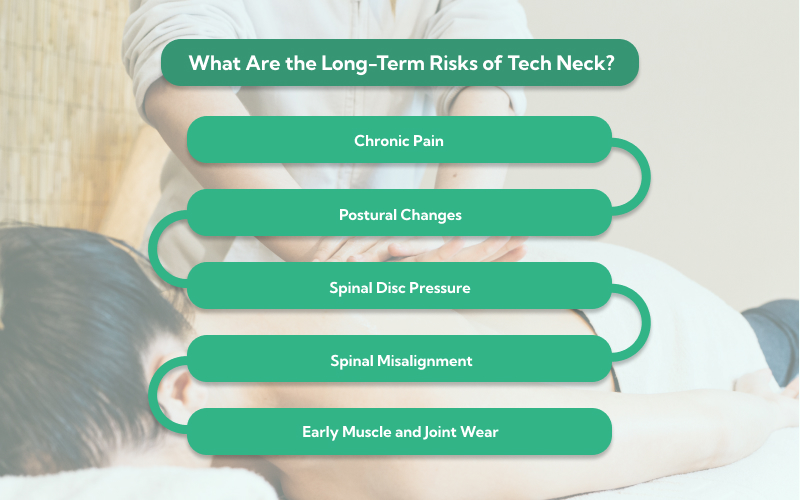
1. Chronic Pain
Continuous strain on the neck and back muscles can gradually lead to lingering discomfort. This persistent ache may begin to interfere with everyday activities and overall quality of life.
2. Postural Changes
Habits such as rounded shoulders or a forward head posture can become ingrained over time. Once established, these patterns make it more difficult to maintain proper spinal alignment, though approaches like acupuncture for posture correction may help support the body’s return to a more natural position.
3. Spinal Disc Pressure
When the spine is under continuous stress, the discs absorb more pressure than they are designed to handle. This can raise the risk of herniation or nerve involvement, potentially resulting in radiating pain or sensory changes.
4. Spinal Misalignment
Structural changes in the spine can build up gradually without obvious warning signs. In the long run, these shifts may require more complex forms of care to correct.
5. Early Muscle and Joint Wear
Even younger individuals can begin to experience premature strain when poor posture is sustained over time. Due to this ongoing stress, individuals may experience early joint degeneration and mobility issues.
Understanding Tech Neck From a TCM Perspective
How TCM Understands the Condition
Having explored the causes, symptoms, and long-term risks of tech neck, it is also useful to view the condition through the lens of TCM. Unlike conventional approaches that focus mainly on muscles and posture, TCM interprets the issue as the result of key patterns that explain why discomfort occurs in the neck and shoulders:
1. Stagnation of Blood and Qi
Poor posture disrupts the smooth flow of blood and Qi along the gallbladder and bladder meridians, which pass through the neck and shoulders. When the head is habitually tilted forward, muscles and soft tissues in this region become tense and compressed, narrowing the pathways through which Qi and blood circulate. This stagnation reduces nourishment to the area and triggers stiffness and soreness.

2. Constraints of Liver Qi
Emotional stress interferes with the liver’s role in regulating the smooth flow of Qi, which in TCM is essential for maintaining flexible and nourished tendons. When this flow is disrupted, the tendons and surrounding muscles may tighten, causing stiffness, tension, or knot-like sensations in the neck and shoulders. This is why approaches such as TCM for stiff neck often focus on supporting smooth liver Qi.
3. Cold and Damp Invasion
Prolonged exposure to air conditioning, common in Singaporean offices, allows cold and dampness to enter the body. These external factors slow circulation, causing the neck to feel heavy, achy, or difficult to move.
4. Chronic Kidney Deficiency
Over time, sustained pressure may weaken Kidney Qi, which nourishes the bones and sinews. This deficiency can delay recovery, make posture harder to maintain, and increase vulnerability to recurring discomfort.
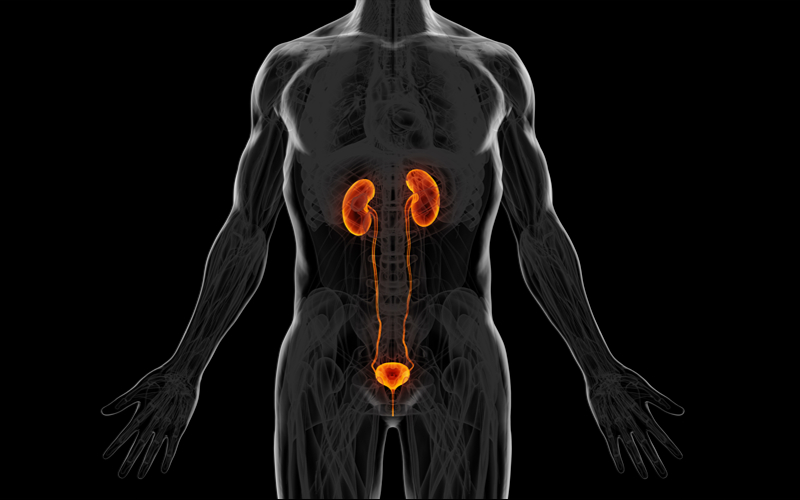
How Acupuncture Can Help
After understanding how tech neck develops and how TCM interprets it, the next step is exploring how acupuncture can support recovery. Rather than focusing solely on surface-level discomfort, acupuncture aims to encourage balance within the body, support circulation, and ease physical strain linked to prolonged device use. By working on specific acupuncture points for muscle tension, it looks to address both the noticeable symptoms and the underlying patterns contributing to the condition.
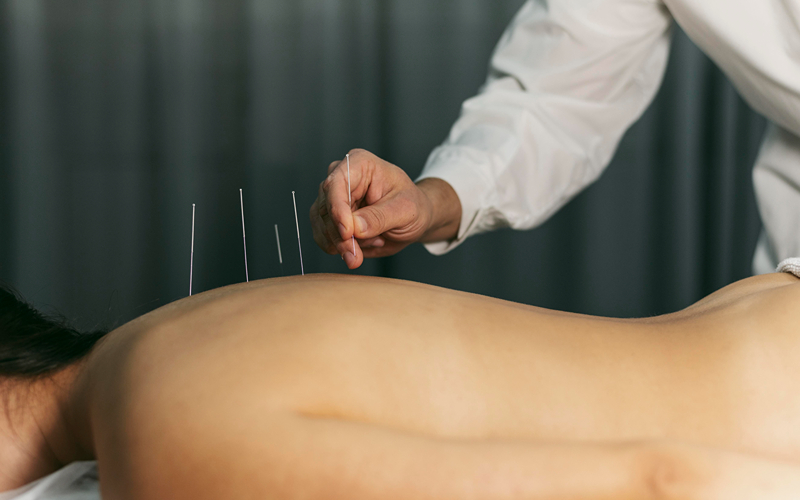
1. Restores Qi and Blood Flow
As one of the commonly used traditional Chinese remedies for muscle tension, acupuncture is believed to support the smooth flow of Qi and blood along the meridians that pass through the neck and shoulders. When circulation is better regulated, muscles may receive improved nourishment, tension can lessen, and maintaining natural alignment may become more manageable.
Needling key points is also thought to help address stagnation and support postural stability in the affected areas:
- GB20 (Fengchi): Relaxes the neck and shoulders while dispelling external wind that may contribute to stiffness.
- SJ5 (Waiguan) and LI4 (Hegu): Regulate Qi flow in the upper body, easing discomfort and supporting circulation.
- BL10 (Tianzhu): Alleviates tension headaches and reinforces neck stability.
- GB21 (Jianjing): A local point that releases tightness in the neck and shoulders and enhances the flow of Qi and blood.
2. Relieves Muscle Tension
Tech neck often develops from a combination of overworked muscles that tighten under strain and weaker ones that struggle to maintain proper posture. Acupuncture is understood in TCM to influence muscle activity by encouraging relaxation in tense areas and supporting the function of underused muscles. This gradual rebalancing may help reduce postural strain and support more sustainable alignment over time.
3. Promotes Stress Release
Emotional stress is closely linked to muscle tension, and addressing it can be an important part of managing tech neck. Acupuncture is thought to affect the body’s internal regulatory systems, potentially influencing the release of neurotransmitters such as endorphins, serotonin, and dopamine. These natural chemicals are associated with modulating pain signals and promoting relaxation, which may ease both physical discomfort and emotional strain. By considering both the physical and mental aspects of the condition, acupuncture takes a more comprehensive approach to managing tech neck and its contributing factors.
What Are Some Complementary TCM Therapies?
While acupuncture is a core part of TCM’s approach to managing tech neck, it is often combined with other therapies that address muscle tension, circulation, and postural imbalances from different angles. These treatments can work together to support the body’s natural healing responses and help prevent symptoms from returning.
1. Tuina Massage
Tuina, a traditional Chinese manual therapy, involves applying rhythmic pressure along specific meridians to ease stiffness and support the smooth flow of Qi and blood. It is commonly used to relieve tight muscles and disperse stagnation associated with neck discomfort. Tuina massage for neck pain may also be combined with herbal patches containing warming ingredients or with natural therapies such as moxibustion, particularly in cases of persistent or recurring tension.
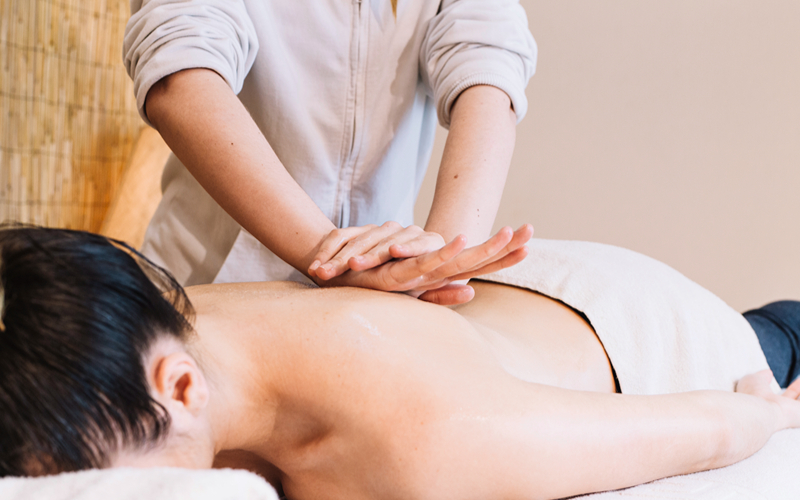
2. Herbal Patches
Herbal patches are applied externally to the affected area and are believed to help reduce discomfort, support circulation, and create a warming effect that eases stiffness. They are often used alongside other TCM methods or natural remedies for chronic neck pain
to complement the therapeutic process.
3. Lifestyle Guidance
Alongside hands-on treatments, TCM physicians often emphasise daily habits that help prevent the recurrence of the issue. These may include gentle stretching routines, posture adjustments during work, and mindful practices that reduce physical and emotional tension throughout the day.
How to Prevent Tech Neck in Daily Life
Prevention often involves making small, consistent adjustments that reduce strain and support healthier posture. Incorporating these changes into your daily routine may help lessen discomfort and maintain neck mobility over time.
1. Optimise Ergonomics
Adjusting your workstation can help reduce unnecessary tension on the neck and spine. Position screens at eye level, use a chair that provides lumbar support, and ensure your feet rest flat on the floor when seated. These practical ergonomic tips for neck pain relief may help minimise postural stress during long periods of sitting.
2. Follow the 20-20-20 Rule
Extended screen use contributes to both neck and eye strain. The 20-20-20 rule offers a simple way to interrupt static postures and give the neck muscles time to recover. It means looking at something 20 feet away for 20 seconds every 20 minutes.
3. Stretch and Strengthen
Incorporating gentle movements such as neck rolls, chin tucks, and shoulder shrugs can help maintain flexibility, while strengthening exercises like rows or wall angels build support for the upper spine. Balancing stretching and strengthening is useful for sustaining posture throughout the day.
4. Balance Work and Relaxation
Introducing short breaks, breathing exercises, or moments of mindfulness into your day may help manage stress levels. Reducing overall tension supports muscle relaxation and can lessen the build-up of strain in the neck and shoulders.
Frequently Asked Questions
1. How many acupuncture sessions are needed for relief?
The number of acupuncture sessions needed can vary depending on the individual and the severity of the condition. Some people may notice changes after one or two sessions, while others might require several weeks of regular treatment. It is advisable to consult an acupuncture TCM clinic for a plan tailored to your specific needs.
2. Is acupuncture safe for treating neck pain?
Yes, when it is performed by a licensed TCM physician. You may feel slight soreness or warmth around the acupuncture points, but this usually subsides quickly.
3. Can acupuncture prevent tech neck from coming back?
Yes. Combined with good posture and ergonomic habits, it helps reduce the chances of tech neck recurring.
Conclusion
Tech neck is a modern concern shaped by today’s screen-focused lifestyles, but it can be managed with appropriate care and informed habits. Approaches such as acupuncture, grounded in TCM philosophy, aim to address both the immediate discomfort and the underlying imbalances contributing to the condition.
For those seeking support, Liang Yi TCM, established in 2016, provides guidance rooted in traditional principles and delivered with a commitment to serve with enthusiasm, integrity, and gratitude. Consulting a TCM physician can help you understand your condition and explore suitable treatment options. If you’re located in the East, you can visit our TCM clinic in Tampines for an assessment and to discuss possible care approaches.
Contact us for a consultation.
